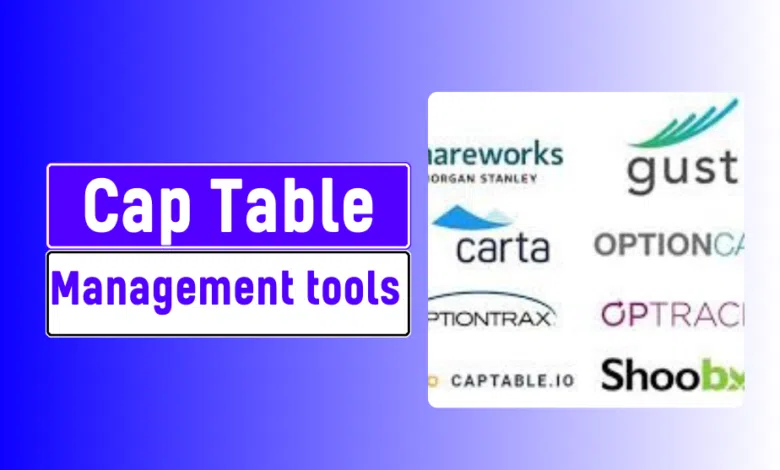7 Game-Changing Cap Table Management Tools You Need in 2024

Introduction
Managing a cap table is essential for any startup or company dealing with equity distribution. With multiple shareholders, investors, and employees involved, keeping an accurate and updated record of stock ownership is vital. In 2024, managing equity has become easier and more streamlined with advanced cap table management tools. These tools simplify tracking shareholder equity, ensuring transparency, and maintaining the balance between founders, employees, and investors.
Let’s explore the 7 game-changing cap table management tools you need in 2024 to streamline equity management and enhance investor relations.
What is cap table management?
What is an example of a cap table?
Why Cap Table Management is Important
What is a Cap Table?
A capitalization table (commonly called a cap table) is a detailed record of a company’s ownership structure. It tracks the distribution of equity, showing the percentage ownership, value of equity, and dilution of founders, investors, and other stakeholders. This record is vital for making informed decisions regarding equity distribution, fundraising, and exit strategies.
Key Features of Cap Table Software
Modern cap table software offers more than just a record-keeping tool. It allows for automated tracking, real-time updates, investor transparency, and compliance management. Here’s why you should consider using cap table management tools in your business:
- Automation: Simplifies complex calculations like dilution and equity distributions.
- Real-Time Updates: Keeps investors and stakeholders informed with the latest data.
- Compliance: Ensures you meet regulatory requirements with ease.
Best Tools for Cap Table Management
(1). Carta – Simplifying Cap Table Management for Startups
Carta is a well-known cap table management tool that helps startups automate equity tracking and streamline shareholder equity. It supports everything from founder equity to employee stock ownership plans (ESOP) and convertible notes management. Carta’s features include:
- Cap Table Automation
- Real-time updates for investors
- Convertible note management
- Compliance with regulatory requirements
Benefits of Using Carta
With Carta, startups can easily manage their cap table while providing transparency to investors and minimizing errors. Its investor relations tools also make it easier to handle VC communications, exit strategy planning, and fundraising events.
(2). Pulley – Efficient Cap Table Tracking Software
Pulley offers a straightforward solution for cap table management and is ideal for early-stage startups. Pulley allows you to visualize your cap table with investor-friendly reports, making it easier for small businesses to manage their equity distribution.
Key Features of Pulley
- Cap table visualization
- Automated dilution calculations
- Stakeholder transparency
Pulley’s equity planning features help startups plan for equity distribution without the need for spreadsheets.
(3). Ledgy – Advanced Cap Table Software for Global Businesses
Ledgy is a powerful equity management software built for companies operating on an international scale. It simplifies equity management by providing features for managing multiple cap tables, tracking employee stock options, and handling founder dilution.
Features of Ledgy
- Multi-currency support
- Detailed equity tracking
- Exit strategy planning tools
- Real-time stakeholder updates
(4). Capdesk – Best for Employee Stock Ownership Management
Capdesk is designed for companies with Employee Stock Ownership Plans (ESOPs). It automates the management of employee equity, helping startups incentivize their workforce while staying compliant with regulations.
What Makes Capdesk Stand Out?
- ESOP management
- Cap table compliance
- Employee equity distribution
With Capdesk, you can manage employee ownership without manually updating your cap table.
(5). Eqvista – A Budget-Friendly Cap Table Software
Eqvista offers a free version of its cap table software, making it ideal for small businesses and startups that need to track equity without the high costs. It provides all the essential features, including equity distribution, shareholder transparency, and cap table automation.
Why Choose Eqvista?
- Cost-effective solution
- Automated equity tracking
- Cap table reports for VC firms
(6). Gust Equity Management – Tailored for Startups and Small Businesses
Gust provides robust cap table management for startups, with tools that support everything from equity distribution to fundraising. It simplifies the process of managing equity stakes and investor relations, offering real-time updates and detailed reporting for investors.
Benefits of Gust
- Automated cap table management
- Investor cap table visualization
- Equity distribution tools
Gust is an excellent option for early-stage companies looking to streamline their ownership structure.
(7). Shareworks by Morgan Stanley – Perfect for Large Enterprises
For enterprises dealing with large, complex cap tables, Shareworks by Morgan Stanley is the go-to solution. It provides advanced features for equity management, including shareholder equity reporting, stock ownership tracking, and compliance tools.
Key Advantages of Shareworks
- Cap table tracking software designed for large companies
- Equity stakeholder management
- Financial equity tools for accurate reporting
Simplifying Equity Distribution with Cap Table Software
In 2024, the rise of digital solutions has made cap table management more efficient and transparent. The right cap table management tools not only simplify the process of tracking equity but also ensure regulatory compliance and improve stakeholder transparency.
Cap Table Software
Whether you’re managing a startup or a large enterprise, having the right cap table tools can significantly impact your business’s success. From cap table automation to real-time updates, the tools mentioned above are some of the best options available in 2024. Stay ahead of the curve by integrating one of these tools into your equity management strategy and enjoy the benefits of a streamlined ownership structure.
Importance of Automated Cap Table Tools
In a fast-paced business environment, automating cap table management can save significant time and reduce errors. Manual updates to equity structures, especially during multiple fundraising rounds, can lead to mistakes and confusion. Automated cap table tools provide real-time data, eliminating discrepancies and ensuring accurate equity tracking.
Key Benefits of Automated Cap Table Tools
- Error Reduction: Automating calculations for equity distribution and dilution prevents manual mistakes.
- Real-Time Data: Automated tools provide updated insights on equity and ownership structure, offering transparency to all stakeholders.
- Scalability: As your company grows, automated tools can seamlessly handle complex equity scenarios such as employee stock ownership plans (ESOPs) or convertible notes.
Simplifying Investor Relations with Cap Table Tools
Managing investor relations can be tricky, particularly when dealing with multiple stakeholders. Cap table tracking software simplifies the communication between your company and its investors by providing clear and accurate reports on shareholder equity and stock ownership. By maintaining transparency, these tools help build trust with investors, which is crucial for long-term growth.
Investor Transparency and Cap Table Compliance
Maintaining investor confidence requires transparency and regulatory compliance. Modern equity management software ensures that all stakeholders have access to the latest data on ownership percentages, making sure you stay compliant with legal requirements. Tools like Carta and Capdesk also generate reports for VC firms and regulatory bodies, streamlining the process and ensuring that nothing falls through the cracks.
Best Practices for Managing Cap Tables in 2024
- Use Automation: Leverage digital cap tables to reduce the workload and eliminate human errors.
- Update Regularly: Keep your cap table updated after every financing round or employee stock issuance to ensure accuracy.
- Stay Transparent: Provide access to shareholders and investors, fostering trust and accountability.
- Plan for Dilution: Use cap table software that calculates dilution automatically to avoid surprises during future rounds of funding.
Choosing the Right Cap Table Software for Your Startup
Choosing the best cap table management tool depends on your company’s specific needs. Here’s a quick guide to help you decide:
Key Features to Look for in Cap Table Software
When selecting a cap table tool, ensure it has the following features:
- Equity Distribution and Dilution Tracking: The software should calculate changes in equity planning automatically.
- Investor Relations Tools: It should offer real-time data for investors to view their equity stakes.
- Regulatory Compliance: Look for tools that generate reports needed for legal compliance and investor reporting.
- Cap Table Automation: Automating tasks like issuing new shares, tracking equity stakeholders, and updating ownership structures is crucial for scaling businesses.
Consider Your Business Size and Growth Stage
Different tools serve different types of businesses. For startups, tools like AngelList, Pulley and Gust are ideal for simplicity and affordability. Larger enterprises with complex equity structures may benefit from more advanced solutions like Shareworks or Ledgy.
Managing Multiple Cap Tables
If your business has multiple subsidiaries or branches, managing various cap tables can be overwhelming. Software like Ledgy and Shareworks simplifies managing multiple cap tables, allowing you to maintain an organized view of the entire equity structure across your business.
Cap Table Management for VC Firms
Venture capital firms often require real-time data on equity holdings across various investments. Tools like Carta and Capdesk offer specialized features for VC firms, providing detailed reports on equity tracking, investor relations, and exit strategy planning.
What distinguishes a share register from a cap table?
The Shareholder Register is a legally binding document that is necessary for regulatory compliance. Cap Table Management Platform: Enables management and strategic decision-making by offering a dynamic and comprehensive view of the company’s equity structure.
The Future of Cap Table Management: Trends to Watch
In 2024, cap table tools will continue to evolve, incorporating features like artificial intelligence, predictive analytics, and blockchain integration. Here’s what to expect:
AI-Powered Cap Table Analytics
AI will play a significant role in analyzing equity data and predicting future trends in equity distribution. These features will help companies plan for future fundraising rounds and assess the impact of new investors on founders’ equity.
Blockchain for Real-Time Cap Table Updates
Blockchain technology can offer greater transparency and security in cap table management. By recording ownership on an immutable ledger, blockchain will allow for real-time updates to stock ownership, ensuring transparency and trust between stakeholders.
Stakeholder Transparency and Collaboration
With new trends in cap table management companies will offer more collaborative platforms for investors, employees, and founders. Real-time dashboards that track equity stakes and provide updates on fundraising rounds will become more common, ensuring everyone involved stays informed and aligned.
Implementing Cap Table Management Tools: A Step-by-Step Guide
Integrating cap table management tools into your business operations can streamline your equity management process and enhance overall efficiency. Here’s a step-by-step guide to help you implement these tools effectively:
Step 1: Evaluate Your Needs
Before selecting a cap table management software, assess your company’s specific needs. Consider factors such as:
- Company Size: Are you a startup, a growing company, or an established enterprise?
- Complexity of Equity Structure: Do you have multiple rounds of funding, convertible notes, or a large number of stakeholders?
- Budget: What is your budget for cap table management tools?
Identifying Key Requirements
Based on your evaluation, identify the key features you need:
- Equity Tracking: Tools that offer automated equity tracking and reporting.
- Compliance: Ensure the software meets regulatory requirements.
- Investor Communication: Tools that facilitate transparent communication with investors.
Comparing Cap Table Tools
Research and compare different cap table management tools based on your requirements. Look for:
- Customer Reviews: Check reviews and testimonials from other users.
- Features: Compare features like automation, real-time updates, and compliance tools.
- Cost: Evaluate pricing plans and consider any additional costs for premium features.
Step 2: Choose the Right Tool
Once you’ve evaluated your needs and compared different options, select the tool that best fits your requirements.
Implementing the Tool
- Integration: Ensure the chosen software integrates well with your existing systems, such as accounting software or CRM platforms.
- Training: Provide training for your team to ensure they understand how to use the software effectively.
- Customization: Customize the tool to fit your specific cap table structure and reporting needs.
Data Migration
- Import Existing Data: Transfer your existing cap table data into the new system carefully.
- Verify Accuracy: Double-check data accuracy after migration to avoid any discrepancies.
Testing and Feedback
- Test Functionality: Conduct thorough testing of the software to ensure it meets your expectations.
- Gather Feedback: Collect feedback from users to identify any issues or areas for improvement.
Step 3: Optimize and Maintain
Once the tool is implemented, focus on optimizing its use and maintaining its effectiveness.
Regular Updates
- Update Cap Table: Keep your cap table updated with the latest equity changes, such as new funding rounds or stock issuances.
- Monitor Performance: Regularly review the performance of the software to ensure it continues to meet your needs.
Continuous Training
- Ongoing Training: Provide ongoing training to your team to keep them updated on any new features or best practices.
- Support: Utilize customer support if any issues arise or if you need assistance with advanced features.
Review and Adjust
- Periodic Reviews: Conduct periodic reviews of your cap table management processes to identify any areas for improvement.
- Adjust as Needed: Make adjustments based on feedback, changing business needs, or new developments in equity management.
Final Thoughts
Managing a cap table has never been easier with the wide range of cap table management tools available today. Whether you’re a startup managing founders’ equity or a large enterprise tracking shareholder equity, there is a tool designed to meet your needs. By choosing the right software, automating tasks, and staying transparent, you can optimize your company’s equity management and investor relations.
Cap table software is essential for managing equity efficiently, ensuring compliance, and fostering strong relationships with investors. As businesses continue to grow, the need for advanced, automated tools will only increase.
FAQ About Cap Table Management Tools
Why should I consider changing my cap table management tools in 2024?
As startups grow, their cap table complexities increase. Switching to a more advanced tool that offers better scalability, automation, and features like equity tracking, scenario modeling, or investor reporting can help streamline operations and avoid costly errors.
What features should I look for in a cap table management tools in 2024?
Look for features like real-time collaboration, automated compliance with regulations, multi-user access, integration with accounting and legal systems, scenario modeling, and reporting tools. Security and scalability should also be top priorities.
How difficult is it to migrate my data when switching cap table management tools?
Most modern cap table management tools offer easy data import options, often through CSV uploads or API integrations. However, it’s crucial to ensure that your historical data and equity records are migrated accurately. Some tools provide support or guided onboarding to assist in this process.
What are the most popular cap table management tools in 2024?
Some of the top-rated tools in 2024 include Carta, Pulley, Ledgy, Shareworks by Morgan Stanley, and Cake Equity. Each has its own strengths, so it’s important to choose based on your startup’s specific needs and stage of growth.
Can I integrate my cap table management tool with other software platforms?
Yes, many modern cap table management tools offer integrations with accounting, HR, legal, and compliance software, such as QuickBooks, Xero, Gusto, and DocuSign. This helps streamline workflows and ensures accurate data sharing across platforms.



4 Comments